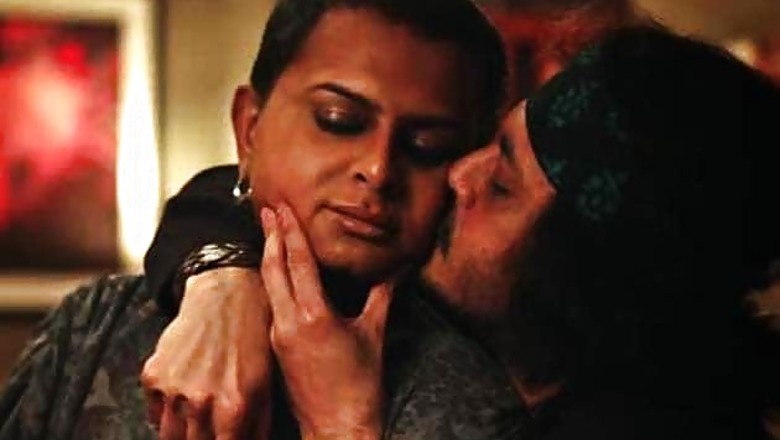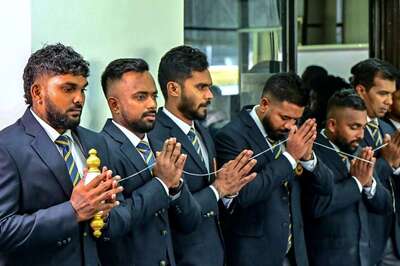
views
New Delhi: When sexual revolution swept through the West in the 1960s after the advent of the birth control pill, some of the effects of the change found slanted reflections in popular culture. But for the ripples to hit the Indian shores, where cinema was still bound by Victorian puritanism, it took another decade. In all of cinema's history, true representation of alternate sexuality happened only as recently as the 70s driven by the worldwide gay rights movement.
While Hollywood cast Bobby Watson as a gay fashion designer named Paisley as early as 1931 in the film 'Manhattan Parade' and Marlene Dietrich kissed a young woman on the lips in 'Morocco' (1930) , Indian films waited another 40 years to even hint at homosexuality.
The mythologies of the nascent era of Indian cinema were gradually giving way to the more realistic family themes of the 40s and then the romantic genre of the 50s. While filmmakers were trying to step outside the beaten track of traditional Indian themes, there was no allowance for portrayal of same sex, a subject that was still taboo in a country where the discourse on sex itself is bound by moral restriction.
There's much archival evidence on the role cinema played in the last 100 years to break taboos and create tolerance towards the transsexuals, transgenders and homosexuals, though it has itself been guilty of perpetuating the worst stereotypes of sexual minorities for cheap laughs.
The third gender
The third gender played a significant role in Indian cinema, mainly in the form of eunuchs who invaded homes of women who have given birth to a male son. But very few serious films tried to focus on the conflicts and politics of their colonised living.
Santhosh Sowparnika's 'Ardhanari', Santosh Sivan's 'Navarasa' and David Atkins' 'Queens! Destiny of Dance' were seen as some later attempts to finally take the 'hijda' community seriously although they started to appear on celluloid in the late 70s in films such as 'Amar Akbar Antony'. The 90s filmmakers were more generous in awarding screen time to some notable third genders in films such as Mahesh Bhatt's 'Tamanna', setting a trend for films of the turn of the century - there were a whole bunch of them - Tamil film Appu (2000), Shabnam Mausi (2005), Shyam Benegal's 'Welcome to Sajjanpur' (2008) and Marathi film 'Jogwa' (2009) among others.
For the first time, there was a concerted effort to empathise with the plight of the 'hijdas' beyond their exploitation in mainstream cinema for comic relief and painting them as a secretive, criminal community of degenerating moral and social system.
In the early years, when the leading men, be it Pramathesh Barua, Kundan Lal Saigal or MG Ramachandran, were still trying to find an identity in an industry that was in an experimental stage, the mannerisms on celluloid were direct extensions of the stage. The nasal dialogue delivery was not considered unusual for a time when cinema was yet to be influenced heavily by the roguish men of American westerns. This was also the time that the definition of the 'effeminate' underwent a sea change.
Foppish heroes of the 60s and 70s mirrored the fashion of their time and wore their hair in a coiffeur and pants hugging their waists. The method of self expression was urbane and distinct. It wasn't unnatural for men to shy away from bloodshed and heavy action till Amitabh Bachchan made grunge the look of the century in an explosive series of films that also cast a death blow to the last of the genteel heroes.
But filmmakers moved on from imparting a certain genteel charm to heroes who wouldn't get their hands dirty to introducing sissies - characters that contrasted with the macho gravity of the hero - for comic relief.
Queer identity
In the last twenty years the queer identity has come to be taken more seriously in arts. Books had men declaring their sexual identity in no uncertain terms while cinema struggled to strike a balance between the morally acceptable lines the makers still complied to with the changing times.
But films nevertheless shied away from any serious reference to homosexuality. Many consider a man's love for a clearly androgynous Paintal dressed as a woman in 'Rafoo Chakkar' (1975) to be cinema's first reference to homosexuality. The lines defining genders get blurred and the spurned lover accepts that 'no one's perfect' in a sexual insight amazingly cynical for its time in the climax.
Since then there have been parallel work in Malayalam, Bengali and Marathi cinema on same sex love. The 1982 Marathi film 'Umbartha' hinted at a lesbian relationship between two inmates of a remand home.
Pratibha Parmar made 'Flesh and Paper' (1990), a short on Indian lesbian poet Suniti Namjoshi. Deepa Metha's Fire (1998) was years late in coming in highlighting the struggles of lonely women trapped in unhappy marriages and bound by convention. But it still stirred up a hornet's nest in a country where sexual equality was a concept unheard of.
Ligy J Pullappally's Malayalam film 'Sancharram' (2004) beautifully portrayed the dilemma of two village belles embracing their sexuality. The 'Kamasutra' was of course the reliable handbook of sex that director Mira Nair adapted to a film in 1996 that celebrated intimacy between women. Buddhadev Dasgupta's Bengali film 'Uttara' (2000), was nuanced with homoerotic themes in his signature non-narrative poetic style.
While the mainstream tried to make its peace with homosexuality, the documentary scene was miles ahead in vision and competition. Nishit Saran filmed 'Summer In My Veins' in 1999 on a mother coming to terms with her son's sexuality.
Kaizad Gustad's 'Bombay Boys' (1998) and Riyad Vinci Wadia's 'Bomgay' were the breakout films of this time to openly discuss homosexuality in the context of urban living.
Dev Benegal was filming 'Split Wide Open' with Rahul Bose and Laila Rouass, another significant narrative on homosexuality, probably at a time Ian Iqbal Rashid was finishing 'Surviving Sabu' - a film about a father and his gay son's
abrasive equation while working on a film project.
At a time when sexual rights were not even discussed in public, actress Rohini Hattangadi played a lesbian lover in Vijay Tendulkar's Marathi film 'Mitrachi Goshta' (1981).
In the south
The earliest references to gay theme in Malayalam cinema was 'Randu Penkuttikal' in 1978. Based on a story by Nanda Kumar, director Mohan narrated the obsessive love of a woman for a danseuse. There are homoerotic references in 'Deshadanakkili Karayaarilla' (1986) and the more recent and famous 'Sanchaaram' (2004), in Rithu (2009) and 'Paranja Katha' (2010).
In Tamil film 'Vettaiyaadu Vilayaadu' (2006), two men molested inside a prison by a gang of hijdas take on a life of crime. In the relatively conservative Tamil creative medium, director Venkat Prabhu managed to slip in a gay character in his film 'Goa'.
The shadow of invisibility
Cinema is undoubtedly the greatest thing to have happened to the queer movement in India. Doubted, ridiculed and criminalized for centuries, the sexual minorities stepped out from the shadow of invisibility after 2000 to claim their rightful place in popular culture. What followed was a plethora of films that were finally sympathetic to their plight.
Meant perhaps to free them from the shackles of strict convention, Madhur Bhandarkar's 'Page 3' (2005), Anurag Basu's 'Life in a... Metro' (2007), Reema Kagti's 'Honeymoon Travels' (2007), Karan Razdan's 'Girlfriend' (2004) and Parvati Balagopalan's 'Rules - Pyar Ka Superhit Formula' (2003) propagated the same gay stereotypes the filmmakers were trying to avoid. The mainstream has largely let down queer cinema.
But a whole host of films - shorts, documentaries and features - around this time were trying to understand the cultural phenomena of the queer movement. Few among those were 'Tedhi Lakeer' (2004), 'Teen Deewarein' (2003), 'My Brother Nikhil', Marathi film 'Thang' (2006), 'Touch of Pink' (2004), 'Stag' (2001), Water (2005), Yours Emotionally (2006), 'Piku Bhalo Aachhey' (Bengali, 2004), 'Happy Hookers' (2006), 'I Can't Think Straight' (2007) and 'Luck by Chance' (2009).
Special hat tip to Sridhar Rangayan, Onir, Rituparno Ghosh
In this context, the contributions of gay rights activists and filmmakers Sridhar Rangayan, Onir and Rituparno Ghosh to the genre have been immense. Rangayan, the assistant director of 'English, August' has made successive films in this genre - 'The Pink Mirror' (2006), 'Yours Emotionally' (2007) and '68 Pages' (2007).
Onir's 'I AM', an anthology film consisting of four short stories, won the National Award for Best Hindi Film and Best Lyrics.
If Sanjoy Nag's 'Memories of March' (2010) was a beautiful story of reconciliation starring Rituparno Ghosh, the latter's 'Chitrangada' (2012) remained restlessly dissatisfied in the search of sexuality. Kaushik Ganguly's Bengali film 'Aarekti Premer Galpo' about a gay director's obsession for his bisexual cinematographer was lauded at international festivals.
Bollywood
Meanwhile mainstream Bollywood tried in its own way to reconcile to the gay theme. But unfortunately the characterisations, even after all these years remained a spoof of a serious subject matter.
Films such as 'Dostana' and more recently 'Student of The Year' tried to introduce homosexuality in the plot but failed to create any commiseration due to the stereotypical spoofing of gay men. While a small section is still attempting to break the ice, it remains the job of a much larger and influential section of the cinema industry to push for reforms and overhaul the writing to bring out sensitive LGBT stories.
####



















Comments
0 comment